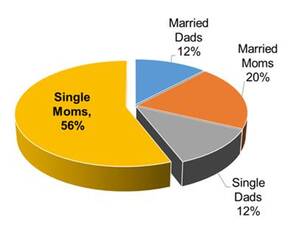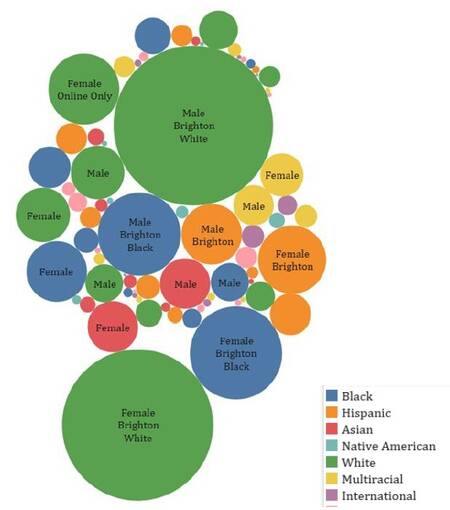Fall 2019 Inside IR
Inside This Issue
Tableau Reports Now Available No Research Request Required!
By William Dixon
Four categories of information are available for users, and the reports contain information that is commonly asked for. The categories include:
- Census Enrollment
- Student Outcomes
- Graduation Rates
- AACC Pathways Key Performance Indicators
The Office of Institutional Research has a new tool available to MCC employees to create their own reports. This tool is listed in the Internal Resources section of the IR website and requires users to log in. Once logged in, click on “Tableau Reports” in the “Internal Data” section near the top of the page.
Tableau Reports allows users to create custom reports based on the census information the College reports to the state and federal governments. Four categories of information are available for users, and the reports contain information that is commonly asked for. The categories include: Census Enrollment, Student Outcomes, Graduation Rates, and AACC Pathways Key Performance Indicators. Each of these reports contains unique information and allows users to look at information over the past five years, three years for graduation rates.
In order to open these reports, users will need to have Tableau Reader installed on their computer. The software is free and a link is provided in the reports area. The Reader has been installed on the majority of computers at MCC.
It is the hope of Institutional Research that these reports will allow users to quickly generate information without having to submit a Research Request. The following are the descriptions of what is contained in each report:
Census Enrollment
This shows the student head-count as of the official fall census. Users can create reports based on term, current student status, MCC School, pathway, degree type, and Pell eligibility.
Student Outcomes
This report allows users to see what happens to students from one fall term to the next fall term. The report includes term, status, sex, age group, degree type, enrollment status, and pathway. Students who graduate or are marked as deceased in Banner are not included in the retention rate calculations.
Graduation Rates
Graduation rates are calculated using the incoming, first time in college cohort and the last pro-gram the student was enrolled in. Using this method, a graduation rate can be calculated for programs that do not directly admit new students.
American Association of Community Colleges (AACC) Pathways Key Performance Indicators
MCC is participating in the Community College Research Center (CCRC) project on Guided Pathways. The project has a set of key performance indicators and this report highlights many of them. Users can drill down by pathway, gender, race/ethnicity, and Pell eligibility.
As new reports are made available, they will be posted in the Tableau Reports area. Reports under development include MCC employees 2005 to present, and the Voluntary Framework of Accountability (VFA) for the past three years.
ENG101 C-or-Better Rates for ALP vs. Non-ALP Students
By Clint Cantwell
An Accelerated Learning Program (ALP) is designed to support students who are not considered college ready in a specific area such as math or English.
An Accelerated Learning Program (ALP) is designed to support students who are not considered college ready in a specific area such as math or English. Co-requisite courses (courses taken simultaneously with the college ready course) are an example of an ALP. TRS099 as a co-requisite to ENG101 is one example of an ALP at MCC.
In spring 2019, a total of 1,426 students enrolled in ENG101, with 175 of those students simultaneously enrolled in TRS099. The overall C-or-Better rate for ENG101 was 44.7%. The C-or-Better rate for students simultaneously enrolled in TRS099 was 56.0%, while it was 43.2% for those not simultaneously enrolled in TRS-099. Table 1 summarizes this data.
This indicates that those enrolled in TRS099 as a co-requisite perform at least as well, if not better, than those without TRS099 as a co-requisite. In fact, a correlation was found between ENG101 C-or-Better rates and simultaneously taking (or not taking) TRS099. However, it is important to note that correlation does not indicate causation. It is not possible to know from this data if TRS099 as co-requisite causes the difference in ENG101 C-or-Better rates. Rather, this data points to a potential benefit from taking TRS099 simultaneously with ENG101.
This indicates that those simultaneously enrolled in TRS099 as a co-requisite course perform at least as well as, if not better than, those without TRS099 as a co-requisite course.
Another ALP is TRS080 paired with MTH150, which was implemented in fall 2015. As more data on ALPs becomes available, the IR Office will analyze student success measures.
Table 1 For ENG101 C-or-Better Rates for ALP vs. Non-ALP Students
| ALP vs. Non-ALP | ENG 101 Total Enrollment | ENG 101 w/o TRS099 | ENG 101 w/ TRS099 |
|---|---|---|---|
| Students w/ COB | 638 | 940 | 98 |
| Total Students | 1,426 | 1,251 | 175 |
| ENG COB Rate | 44.74% | 43.17** | 56.00%** |
**Statistically significant difference, p<.05
Update on the Single Moms Success Design Challenge Grant
By Mary Ann M. DeMario
SMSDC Core Team: Mary Ann M. DeMario (Lead), Julianna Frisch, Kim DeLardge, Heather Cruz, Peggy Harvey-Lee, Vilma Patterson, Medea Rambish, Victoria Boese, Rosanna Yule, Junior Dillion, and Marcy Lynch
In spring 2019, MCC was one of four community colleges nationwide awarded the Single Moms Success Design Challenge (“SMSDC”) grant. A six-year long, student-centered design process, the grant overseen by the Education Design Lab and funded by the ECMC Foundation. At MCC, the grant is being implemented by an inter-divisional Core Team.
As stated on the Education Design Lab’s website: “The challenge goal is to improve attainment rates of degrees or high-quality credentials by 30% at each institution by 2024. As a portfolio, the cohort will improve the education outcomes for a total of 6,000 - 8,000 single mother learners.”
MCC was selected because we are the only college in the nation that collects data on our students’ marital and parental status. We are also the only college that has quantified the experiences and needs of its “Student-Parents,” particularly, its Single Mom Learners.
As compared to MCC Non-Parents, our Student-Parents are disproportionately first-generation college students and living below the poverty line. Among MCC Single Mom Learners, who make up more than half of our Student-Parent population (see Figure 1), the disparities are even starker. Nearly three-quarters of Single Mom Learners are first-generation college students and more than nine in 10 live below the poverty line.
Since May, the MCC SMSDC Core Team has been conducting interviews with MCC faculty, staff, and Single Mom Learners. Over the summer, quantitative and additional qualitative data were collected using a survey designed specifically for MCC Student-Parents.
Nearly three-quarters of Single Mom Learners are first-generation college students and more than nine in 10 live below the poverty line.
In spring 2020, the Core Team will begin testing prototypes designed to help increase, by 30%, MCC Single Mom Learners’ six-year rates of graduation and/or transfer to a four-year college.
Figure 1 For Update on the Single Moms Success Design Challenge Grant
Figure 1: MCC Student-Parents by Type: 2018-19

Who Are Our Students?
By Elina Belyablya
MCC diversity has been increasing year over year. This semester, students of color make up close to 43% of the student body. The percent of students of color varied by campus:
- Brighton Only 39%
- Downtown Only 66%
- Brighton and Downtown 57%
The fall 2019 census included 1,292 students who took all their courses online, the majority of whom were degree-seeking (78%). This group topped a thousand for the first time in MCC history. Students with an all online load accounted for 11% of fall enrollment. This group was mostly female (67%), age 25 or older (54%), and white (61%).
The median age of students, age 21, has not changed in the past 10 years.
Most MCC students (60%) are currently taking a full time load in the fall.
Figure 2 illustrates the proportions of students by sex, campus, and race/ethnicity. Table 2 specifies the data from the same information.
Figure 2 For Who Are Our Students?
Figure 2: Fall 2019 Students by Sex, Campus, and Race/Ethnicity

Table 2 For Who Are Our Students?
Table 2: Fall 2019 Students by Sex, Campus, and Race/Ethnicity
| Race/Ethnicity | Brighton | Brighton/ DC | Online Only | DC | PSTF & Other | Total |
|---|---|---|---|---|---|---|
| American Indian | 25 | 7 | 3 | 3 | 1 | 39 |
| Asian | 244 | 14 | 27 | 18 | 0 | 303 |
| Black | 850 | 235 | 172 | 264 | 10 | 1,531 |
| Hispanic | 463 | 95 | 96 | 117 | 7 | 778 |
| International | 39 | 2 | 5 | 0 | 0 | 46 |
| Multi-Racial | 186 | 32 | 45 | 37 | 3 | 303 |
| Pacific Islander | 10 | 1 | 1 | 0 | 0 | 12 |
| Unknown | 36 | 6 | 9 | 16 | 2 | 69 |
| White | 2,282 | 255 | 503 | 188 | 49 | 3,277 |
| Race/Ethnicity | Brighton | Brighton/ DC | Online Only | DC | PSTF & Other | Total |
|---|---|---|---|---|---|---|
| American Indian | 17 | 0 | 4 | 1 | 0 | 22 |
| Asian | 256 | 14 | 15 | 12 | 3 | 300 |
| Black | 687 | 79 | 62 | 102 | 10 | 940 |
| Hispanic | 373 | 45 | 44 | 35 | 15 | 512 |
| International | 49 | 3 | 6 | 0 | 0 | 58 |
| Multi-Racial | 163 | 9 | 6 | 8 | 3 | 189 |
| Pacific Islander | 3 | 0 | 1 | 1 | 0 | 5 |
| Unknown | 47 | 2 | 6 | 3 | 4 | 62 |
| White | 2,540 | 123 | 287 | 90 | 86 | 3,126 |
Grand Totals of Students by Campus:
- Brighton: 8,270
- Brighton/DC: 922
- Online Only: 1,292
- DC: 895
- PSTF & Other: 193
- Total Combined: 11,572
“What Happened to the Class of 2018?"
By Mary Ann M. DeMario
The “What Happened to the Class of 2018?” book and brochure are posted on the IR website. Hard copies will soon be distributed on and off campus.
During the 2017-18 academic year, MCC awarded 1,959 associate degrees and 319 certificates. Outcome data was collected on 68% of graduates. Some of the report highlights include:
- 67% of graduates are employed and/or continuing their education.
- Local employers continue to hire the majority of our graduates who enter the workforce. Of the career and certificate program graduates who secured full-time employment, 96% are employed in Monroe or an adjacent county.
- 68 percent of the graduates who transferred are attending SUNY or CUNY institutions.
Graduates’ outcomes by award type are shown in detail in the report.
Additional Information & Contacts
For more information, you can visit the Institutional Research (IR) website or contact an IR staff member:
- William Dixon, Director, (585) 292-3031
- Elina Belyablya, Assistant Director, (585) 292-3033
- Mary Ann Matta DeMario, Specialist, (585) 292-3032
- Allison Wanek, Clerk, (585) 292-3035
Previous issues of Inside IR are available through our Newsletters webpage.

